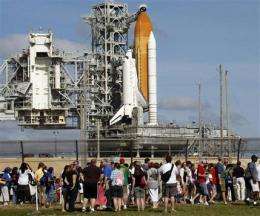Discovery blasts off for International Space Station

The US space shuttle Discovery blasted off at dawn Monday toward the International Space Station for a mission that will put more women in orbit than ever before.
Discovery lifted off from Launch Pad 39A at the Kennedy Space Center in Cape Canaveral, Florida at 6:21 am (1021 GMT) as scheduled.
The two booster rockets, which account for 80 percent of the shuttle's lift during takeoff, peeled away as planned 120 seconds after the launch. They fell into the Atlantic Ocean, where they will be subsequently retrieved and reused.
The shuttle reached Earth's orbit eight and a half minutes after launch, moving at five times the speed of sound to reach 16,155 miles (26,000 kilometers) per hour.
Once it goes into orbit some 140 miles (225 km) above Earth, Discovery will begin its race toward the ISS, itself located 213 miles (343 km) above Earth.
Discovery's planned arrival at the International Space Station is tentatively scheduled for Wednesday and will be one of the final missions for the shuttle program, which will be shuttered later this year.
It is the first shuttle mission with three female crew members and will also mark a first in space, with four women in orbit.
Only three more space shuttle flights are planned before all three remaining US manned orbiters are retired at the end of 2010, ending 30 years of service. The first shuttle flew in April 1981.
During the 13-day mission, Discovery and its crew will deliver nearly eight tonnes of cargo, including spare bunks for the occupants of the space station, a large tank of ammonia coolant and seven racks filled with science experiments.
American Tracy Caldwell Dyson arrived at the orbiting space station on Sunday aboard a Soyuz spacecraft with two Russian cosmonauts.
Joining Dyson from Discovery will be mission specialists Dottie Metcalf-Lindenburger, 34, a former high school science teacher; Stephanie Wilson, 43, a veteran of two shuttle missions; and Naoko Yamazaki, 39, an astronaut with the Japanese space agency since 1996.
Rounding out the Discovery crew are mission commander Alan Poindexter, 48; co-pilot Jim Dutton, 41; mission specialist and spacewalker Rick Mastracchio, 50; and fellow spacewalker Clay Anderson, 51.
Among the gear being hauled into space is a freezer to preserve samples of blood, urine, saliva, plants or microbes used in micro-gravity experiments and then analyzed later back on Earth.
Discovery is also carrying an exercise machine designed to study the effects of micro-gravity on the body's musculoskeletal system. Muscles can atrophy during long sojourns in space so astronauts have to take care to exercise regularly.
The supplies, racks and other gear are packed into a pressurized Italian-built module named Leonardo, carried in the shuttle's bay.
Until construction of the orbital outpost is completed, NASA has to ferry spare parts and gear to maintain the space station and service the scientific experiments on board.
Two Discovery astronauts will conduct three space walks lasting six and a half hour each on days five, seven and nine of the mission.
One of their principal and most complex tasks will be to replace an empty ammonia tank attached to the rear of the station with one that is full. Ammonia is used in the station's cooling system.
The ISS, a hundred billion dollar project begun in 1998 with the participation of 16 countries, is financed mainly by the United States.
In presenting his 2011 budget proposal in February, President Barack Obama announced that the space station will be maintained until at least 2020.
Once the shuttle program ends, the United States will depend on Russian Soyuz spacecraft to ferry their astronauts to the ISS until a new US launch vehicle is ready to take over around 2015.
(c) 2010 AFP




















